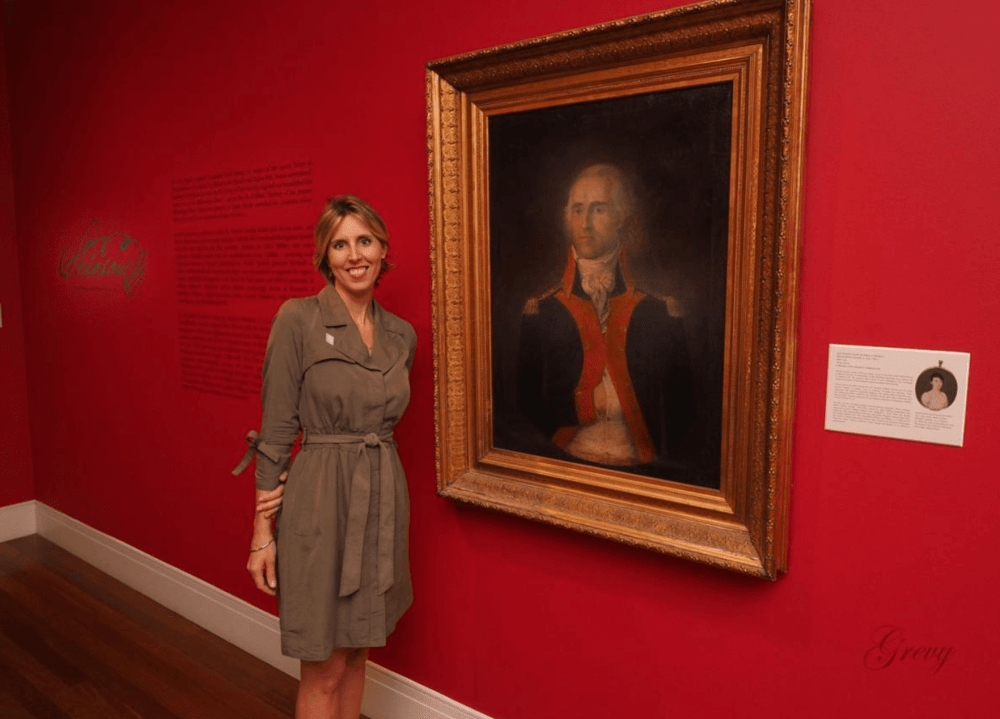
Curator Cybele Gontar stands with Josef Salazar's portrait of Martin Duralde, a Spanish official whose daughter Clarisse married Louisiana's first American governor William Claiborne.
Photo courtesy of Grevy Photography
Art historian and Julia Street gallery owner Cybèle Gontar felt something was missing from the lineup of art events celebrating the city’s tricentennial.
“Josef Salazar (Josef Francisco Xavier de Salazar y Mendoza) was the leading portrait painter in colonial New Orleans from 1785 to 1802, yet he is poorly recognized here,” she said. “I was astonished that there were no exhibits planned of works by the painter who captured the social and political life of the city just when it was on the cusp of becoming Americanized — he was totally obscure.”
Now, thanks to Gontar and the Ogden Museum, the issue has been remedied with the exhibit “Salazar: Portraits of Influence in Spanish New Orleans,” curated by Gontar and on view through Labor Day weekend, Sept. 2, on the Ogden’s fourth floor. A sumptuous book accompanies the show.
“When Cybèle came to us about the exhibit, we thought it would fit well with the Ogden’s desire to contribute to the city’s tricentennial programming,” said Ogden director William Andrews. “She put together a great show.”
Works in the exhibition are irresistibly intriguing on several levels. First, the portraits are downright gorgeous. The subjects, their garb and their poses are arresting and appealing. They demonstrate Salazar’s painting technique and skill, which is au courant with trends in the late 18th century.
Second, they offer insights into domestic life in the city in the late 1700s, for they depict men, women and children, sometimes singly but more often together in family groups. And finally, they feature images of many of the most prominent citizens of New Orleans’ Spanish Colonial era, which helps bring a remote time to life for viewers.
Salazar was born in 1750 in Merida, Mexico, into a prominent family descended from 16th-century Spanish conquerors. It isn’t known why he left Mexico but he moved to New Orleans in 1784 with his wife and daughter, Francisca.
Salazar would have been well-connected because of his own heritage and would have had little trouble gaining social and political introductions to people of means — prospective clients — in what was then a small city of 4,000.
Gontar said there is little in the record that indicates if or where Salazar received training in painting, although a diarist at the time referred to him as “the celebrated self-taught portrait painter.”
Despite that reference, his sophisticated style suggests that he had received at least some training before relocating to New Orleans. Moreover, from his new home, it was possible for him to keep an eye on international trends in fashion and portrait painting.
Gontar said only about 50 works by Salazar are known to exist.
“If family record keeping wasn’t good, or if the painting were over cleaned, the identity of the artist could be obscured over time,” she said. “But there are a couple of stylistic elements that can help identify works by Salazar.”
One is a reddish glow in the background, produced when the top layer of paint has been abraded or thinned enough to show the red undercoat that Salazar would apply to his canvasses. The practice was common in Spain at the time and serves as additional support for the notion that the portrait painter kept a close eye on European trends.
Salazar often placed many of his subjects in a loosely configured oval frame painted on the canvas, and also included drapery in the background.
Gontar spent more than five years searching for as many Salazar portraits as possible and requesting permission to borrow works for the exhibit.
“There are about 30 paintings in the show — and about half come from institutions like the New Orleans Museum of Art, the Historic New Orleans Collection, and the Louisiana State Museum,” she said. “Portraits were expensive, only certain people could afford to have them, so they were prized. Many portraits in the show are held in private collections, passed down from one generation to the next.”
A case in point is the stunning portrait of Madame Michel Fortier II.
“The first thing we notice is that she is wearing a ‘chemise a la reine’ — the loose fitting muslin gown that Marie Antoinette made popular,” she said. “The gown was a rebellion against the structure of the court when Marie Antoinette wore it, but in New Orleans, it was both fashionable and functional, because it was well-suited to the climate.”
Mme. Fortier’s hair is also loose and unpowdered. She holds a piece of fruit and her daughter (the child at her side, Marie Félicité Julie Fortier) holds two roses in one hand and a sprig of jasmine in the other. The daughter also wears a loose chemise and her hair is similarly unstyled.
“We can see in the portraits a number of details of domestic life — Windsor chairs in some of the paintings, a pianoforte, a small gilt table, arrangements of fruit,” said Gontar. “If we are curious about what life among people means was like in New Orleans in its late colonial era, we have these works of art to offer us clues.”
Descendants of Mme. Fortier visited the exhibited en masse in June and were treated by Gontar to a private tour that not only put their ancestor (the grandmother of planter Valcour Aime whose St. James Parish plantation was known as Le Petit Versailles) in historical perspective but yielded information about others painted by Salazar, including the clergy, the military, and the political movers and shakers of the era.
“Salazar painted portraits during one of the city’s pivotal eras when all of the powerful people were trying to elbow each other out of the way,” said Gontar. “His paintings record it all.”
**************
Salazar Exhibit Tour
6 p.m., Saturday (Aug. 4)
The Ogden Museum of Southern Art
925 Camp Street
Free (White Linen Night)
(504) 539-9600